Cement-Treated Volcanic Scoria for Low-Traffic Road Pavements in the Azores Archipelago
Abstract
:1. Introduction
2. Materials and Methods
2.1. Materials and Sample Preparation
2.2. Test Methods
3. Results and Discussion
3.1. Geotechnical Properties
3.2. Mechanical Performance
3.2.1. Indirect Tensile Strength
3.2.2. Unconfined Compressive Strength
4. Conclusions
Author Contributions
Funding
Acknowledgments
Conflicts of Interest
References
- Pordata Base de Dados Portugal Contemporâneo. Available online: Pordata.pt/en/Home (accessed on 5 January 2021).
- Lomoschitz, A.; Yepes, J.; de Santiago, C. Basic properties of non welded basaltic lapilli and influence on their geotechnical behaviour. In Volcanic Rock Mechanics-Rock Mechanics and Geo-Engineering in Volcanic Environments; Olalla, C., Hernández, L.E., Rodríguez-Losada, J.A., Perucho, Á., González-Gallego, J., Eds.; CRC Press/Balkema, Taylor & Francis Group: London, UK, 2010; pp. 39–44. ISBN 978-0-415-58478-4. [Google Scholar]
- Hernández, L.E.; Rodríguez-Losada, J.A.; Olalla, C.; Garrido-Manrique, J. Geotechnical investigation guide for building in volcanic environments. In Volcanic Rock Mechanics-Rock Mechanics and Geo-Engineering in Volcanic Environments; Olalla, C., Hernández, L.E., Rodríguez-Losada, J.A., Perucho, Á., González-Gallego, J., Eds.; CRC Press/Balkema, Taylor & Francis Group: London, UK, 2010; pp. 249–254. ISBN 978-0-415-58478-4. [Google Scholar]
- Franesqui, M.A.; Yepes, J.; García-González, C.; Gallego, J.; Pérez, I. Áridos de islas volcánicas Para Capas Granulares de Firmas de Carretera. In Proceedings of the Madrid 2015-IV Congreso Nacional de Áridos, Madrid, Spain, 30 September–2 October 2015; pp. 489–499. [Google Scholar]
- Franesqui, M.A.; Yepes, J.; García-González, C.; Jubera, J.; Hernández-Gutiérrez, L.E.; Gallego, J.; Pérez, I. Caracterización de Áridos Volcánicos de Canarias y Aplicaciones en la Construcción de Carreteras. In Proceedings of the Madrid 2015-IV Congreso Nacional de Áridos, Madrid, Spain, 30 September–2 October 2015; pp. 507–519. [Google Scholar]
- Mfinanga, D.A.; Kamuhabwa, M.L. Use of natural pozzolan in stabilising lightweight volcanic aggregates for roadbase construction. Int. J. Pavement Eng. 2008, 9, 189–201. [Google Scholar] [CrossRef]
- Fraga, C. Caracterização geotécnica de escórias vulcânicas; Universidade Nova de Lisboa: Lisboa, Portugal, 1988. [Google Scholar]
- Malheiro, A.M.; Sousa, J.F.V.; Marques, F.M.; Sousa, D.M. Contribution to geotechnical characterization of Basaltic pyroclasts. In Volcanic Rock Mechanics-Rock Mechanics and Geo-engineering in Volcanic Environments; Olalla, C., Hernández, L.E., Rodrígues-Losada, J.A., Perucho, Á., González-Gallego, J., Eds.; CRC Press/Balkema, Taylor & Francis Group: London, UK, 2010; pp. 53–57. ISBN 978-0-415-58478-4. [Google Scholar]
- FOM/2523/2014. Pliego de Prescripciones Técnicas Generales para Obras de Carreteras y Puentes (PG-3); Dirección General de Carreteras; Centro de Publicaciones, Ministerio de Fomento: Madrid, Spain, 2015.
- Franesqui, M.A.; Castelo Branco, F.; Azevedo, M.C.; Moita, P. Construction experiences with volcanic unbound aggregates in road pavements. In Volcanic Rock Mechanics-Rock Mechanics and Geo-engineering in Volcanic Environments; Olalla, C., Hernández, L.E., Rodríguez-Losada, J.A., Perucho, Á., González-Gallego, J., Eds.; CRC Press/Balkema, Taylor & Francis Group: London, UK, 2010; pp. 241–247. ISBN 978-0-415-58478-4. [Google Scholar]
- Gündüz, L.; Uǧur, I. The effects of different fine and coarse pumice aggregate/cement ratios on the structural concrete properties without using any admixtures. Cem. Concr. Res. 2005, 35, 1859–1864. [Google Scholar] [CrossRef]
- Hossain, K.M.A. Blended cement and lightweight concrete using scoria: Mix design, strength, durability and heat insulation characteristics. Int. J. Phys. Sci. 2006, 1, 005–016. [Google Scholar]
- Kiliç, A.; Atiş, C.D.; Teymen, A.; Karahan, O.; Ari, K. The effects of scoria and pumice aggregates on the strengths and unit weights of lightweight concrete. Sci. Res. Essays 2009, 4, 961–965. [Google Scholar]
- Hossain, K.M.A.; Ahmed, S.; Lachemi, M. Lightweight concrete incorporating pumice based blended cement and aggregate: Mechanical and durability characteristics. Constr. Build. Mater. 2011, 25, 1186–1195. [Google Scholar] [CrossRef]
- Parhizkar, T.; Najimi, M.; Pourkhorshidi, A.R. Application of pumice aggregate in structural lightweight concrete. Asian J. Civ. Eng. 2012, 13, 43–54. [Google Scholar]
- CEN. EN 13286-50:2004, Unbound and Hydraulically Bound Mixtures-Part 50: Method for the Manufacture of Test Specimens of Hydraulically Bound Mixtures Using Proctor Equipment or Vibrating Table Compaction; European Committee for Standardization: Brussels, Belgium, 2004. [Google Scholar]
- CEN. EN 13286-2:2010/AC:2012, Unbound and Hydraulically Bound Mixtures-Part 2: Test Methods for Laboratory Reference Density and Water Content-Proctor Compaction; European Committee for Standardization: Brussels, Belgium, 2012. [Google Scholar]
- CEN. EN 933-1:2012, Tests for Geometrical Properties of Aggregates—Part 1: Determination of Particle Size Distribution—Sieving Method; European Committee for Standardization: Brussels, Belgium, 2012. [Google Scholar]
- CEN. EN1097-6:2013, Tests for Mechanical and Physical Properties of Aggregates—Part 6: Determination of Particle Density and Water Absorption; European Committee for Standardization: Brussels, Belgium, 2013. [Google Scholar]
- ASTM. C125-13a—Standard Terminology Relating to Concrete and Concrete Aggregates; ASTM: West Conshohocken, PA, USA, 2013. [Google Scholar]
- CEN. EN 933-8:2012+A1:2015, Tests for Geometrical Properties of Aggregates—Part 8: Assessment of Fines—Sand Equivalent Test; European Committee for Standardization: Brussels, Belgium, 2015. [Google Scholar]
- CEN. EN 933-9, Methylene Blue Test; European Committee for Standardization: Brussels, Belgium, 2013. [Google Scholar]
- ASTM. D2974-20e1, Standard Test Methods for Determining the Water (Moisture) Content, Ash Content, and Organic Material of Peat and Other Organic Soils; ASTM: West Conshohocken, PA, USA, 2020. [Google Scholar]
- CEN. EN 13286-41:2003, Unbound and Hydraulically Bound Mixtures-Part 41: Test Method for the Determination of the Compressive Strength of Hydraulically Bound Mixtures; European Committee for Standardization: Brussels, Belgium, 2003. [Google Scholar]
- CEN. EN 13286-42:2003, Unbound and Hydraulically Bound Mixtures-Part 42: Test Method for the Determination of the Indirect Tensile Strength of Hydraulically Bound Mixtures; European Committee for Standardization: Brussels, Belgium, 2003. [Google Scholar]
- CEN. EN 12390-2:2009, Testing Hardened Concrete-Part 2: Making and Curing Specimens for Strength Tests; European Committee for Standardization: Brussels, Belgium, 2009. [Google Scholar]
- Crucho, J.M.L.; Picado-Santos, L.G.; Neves, J.M.C. Assessment of a Cement Bound Granular Mixture Using Recycled Concrete Aggregate and Coconut Fiber. In Proceedings of the International Airfield & Highway Pavements Conference, Austin, TX, USA, 6–9 June 2021. [Google Scholar]
- Crucho, J.; Neves, J.; Capitão, S.; Picado-Santos, L. Mechanical performance of asphalt concrete modified with nanoparticles: Nanosilica, zero-valent iron and nanoclay. Constr. Build. Mater. 2018, 181, 309–318. [Google Scholar] [CrossRef]
- Martinho, F.C.G.; Picado-Santos, L.G.; Capitão, S.D. Feasibility assessment of the use of recycled aggregates for asphalt mixtures. Sustainability 2018, 10, 23. [Google Scholar] [CrossRef] [Green Version]
- IP. Specifications; Estradas de Portugal, S.A.: Almada, Portugal, 2014. [Google Scholar]
- South African National Roads Agency Standards. In South African Pavement Engineering Manual; SANRA: Pretoria, South Africa, 2014; ISBN 978-1-920611-04-0.
- Austroads. Guide to Pavement Technology Part 4D-Stabilised Materials, 2nd ed.; Austroads: Sydney, Australia, 2019; ISBN 978-1-925854-12-1. [Google Scholar]
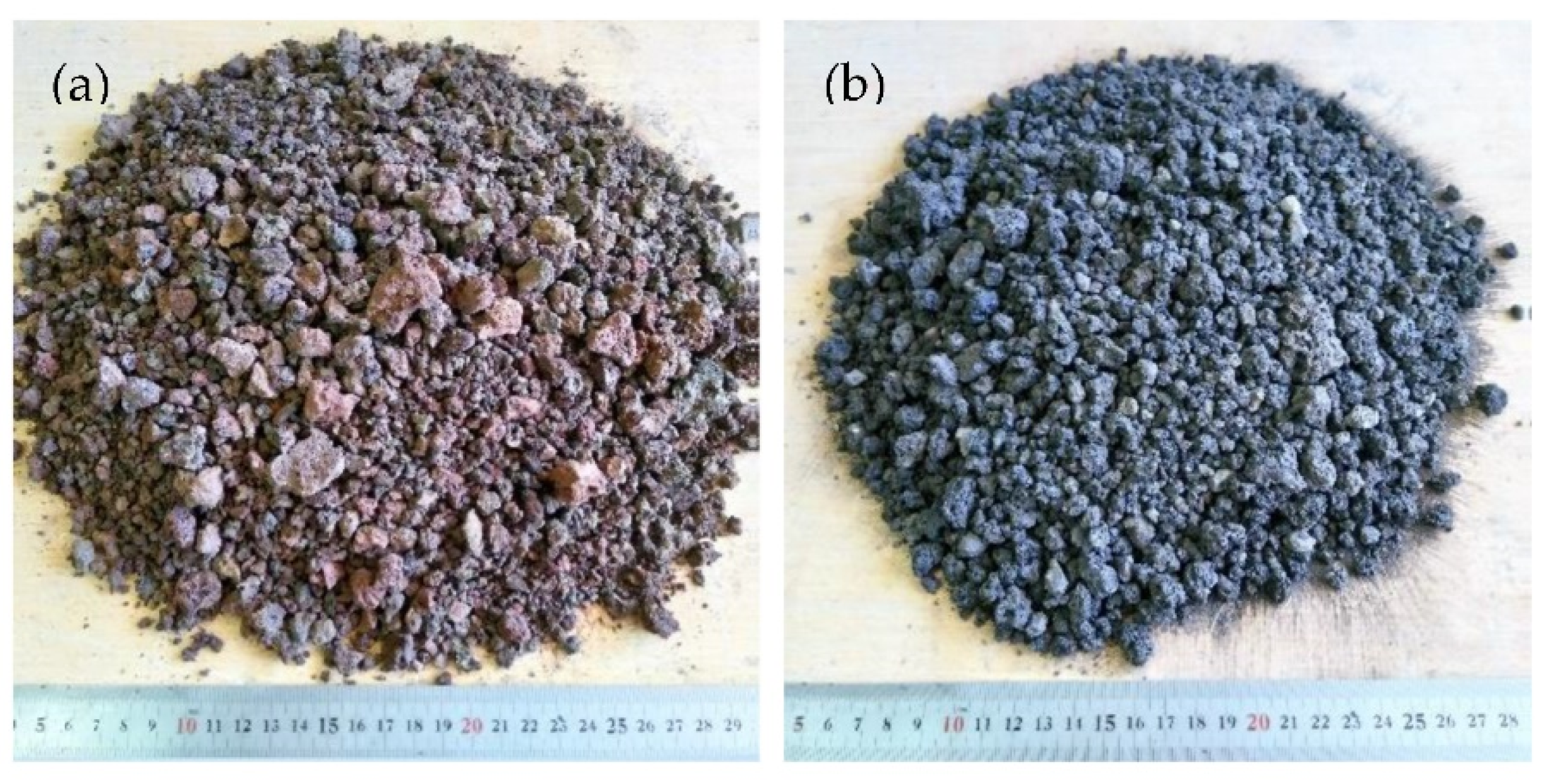


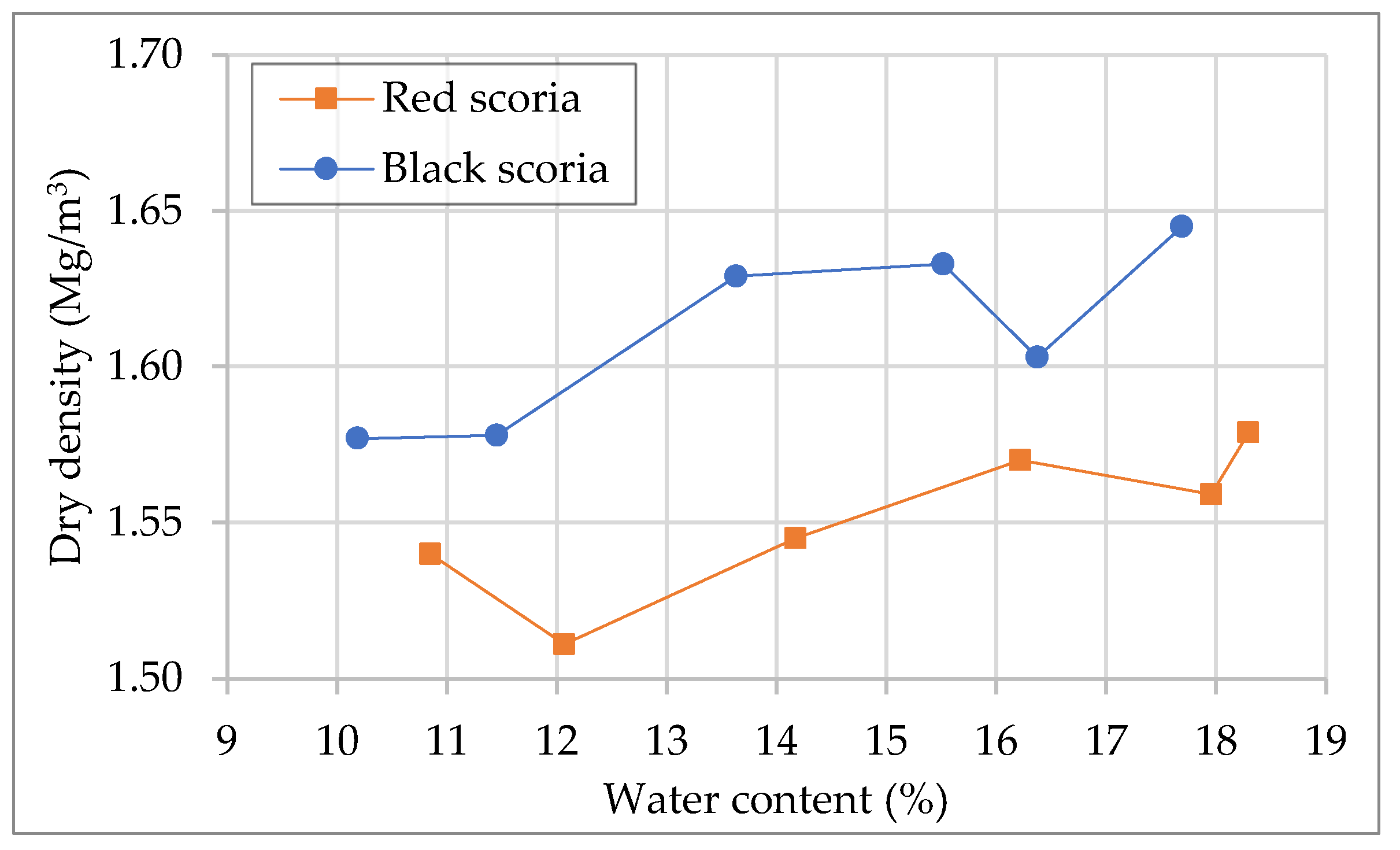
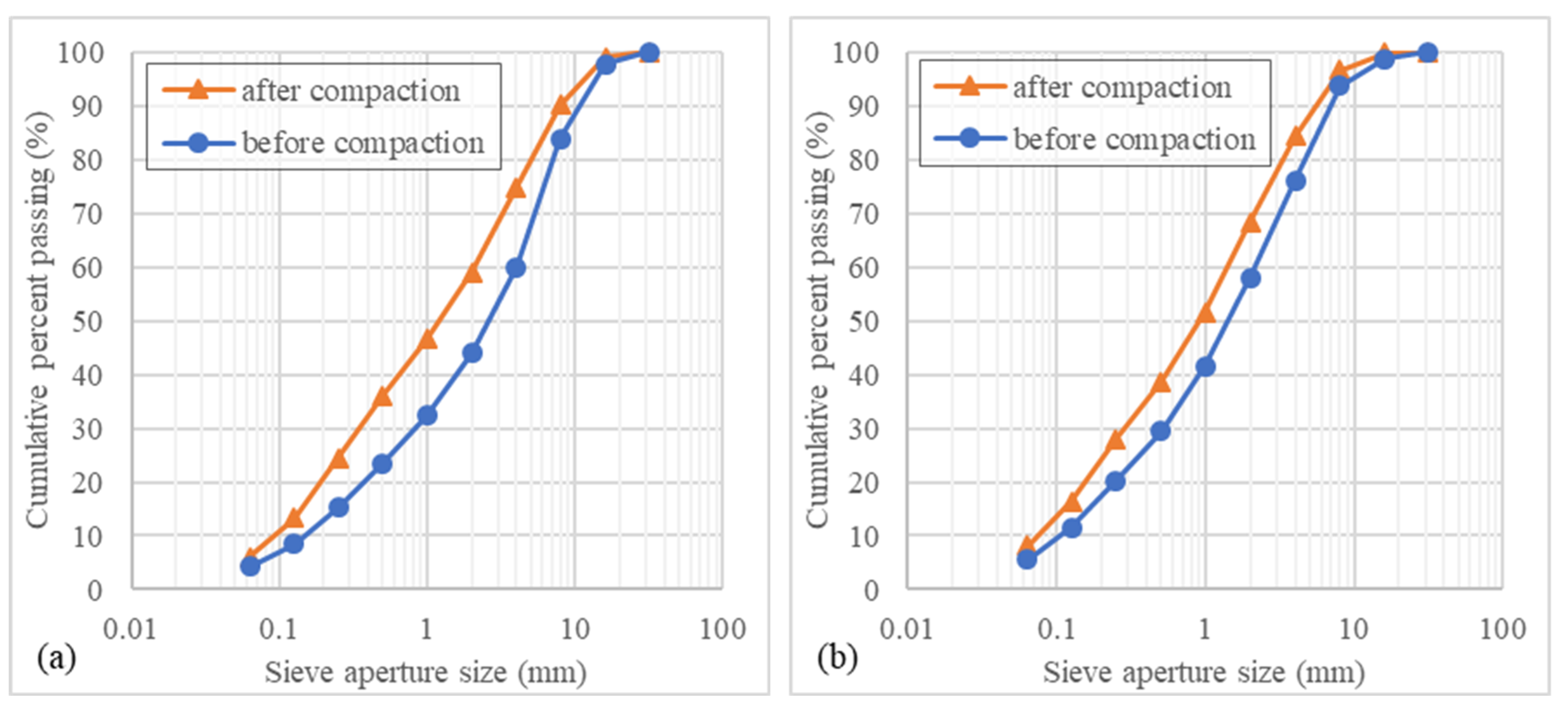

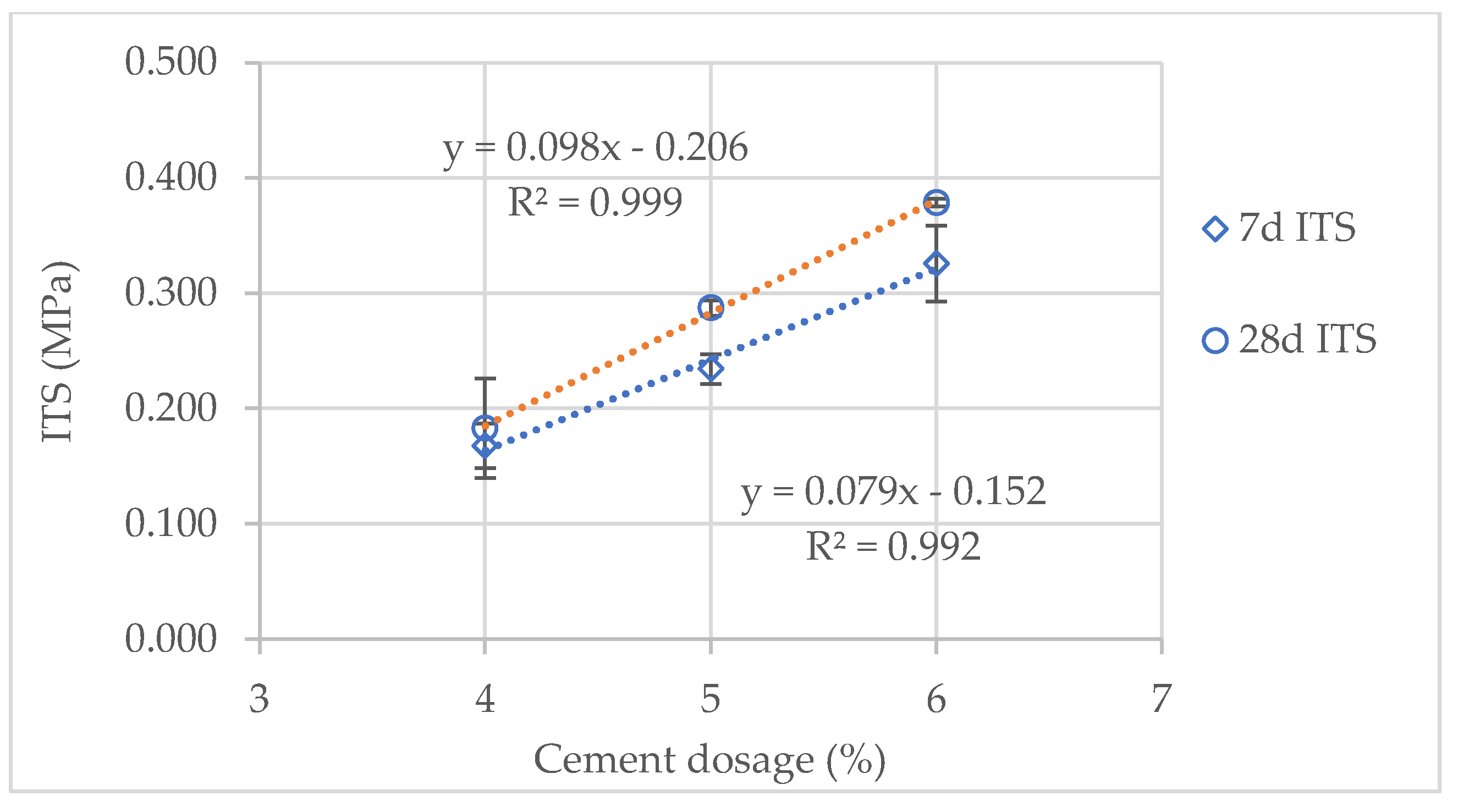
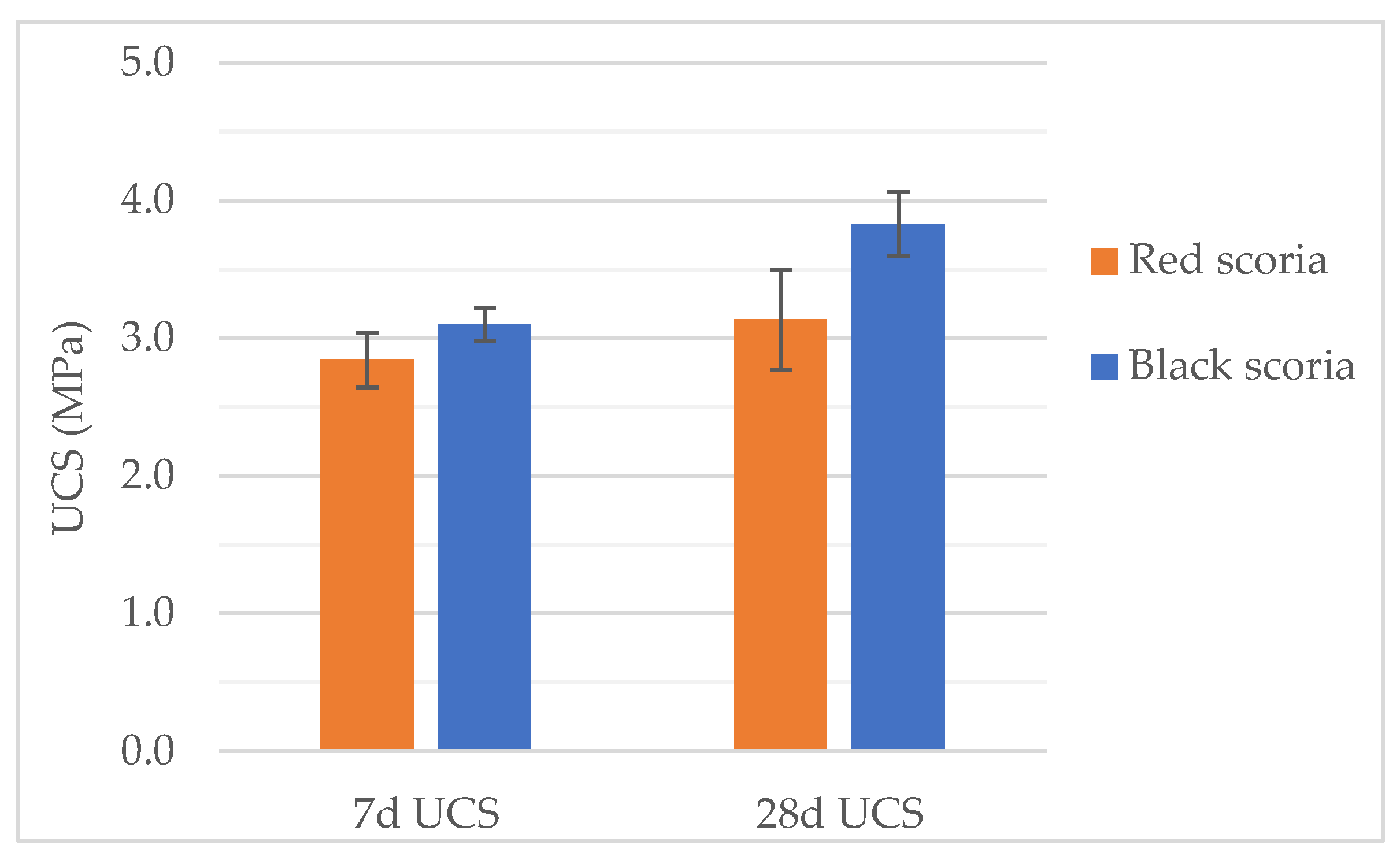
| Test/Parameter | Test Standard |
|---|---|
| Particle size distribution | EN 933-1 [18] |
| Particle density and water absorption | EN 1097-6[19] |
| Fineness modulus | ASTM C125[20] |
| Sand equivalent | EN 933-8[21] |
| Methylene blue | EN 933-9[22] |
| Organic matter | ASTM D2974[23] |
| Parameter | Type of Scoria | ||
|---|---|---|---|
| Red | Black | ||
| Fraction 0.063/4—Apparent particle density | Mg/m3 | 2.37 | 2.48 |
| Fraction 0.063/4—Particle density on an oven-dried basis | Mg/m3 | 2.29 | 2.45 |
| Fraction 0.063/4—Particle density on a saturated and surface-dried basis | Mg/m3 | 2.32 | 2.46 |
| Fraction 0.063/4—Water absorption | % | 1.53 | 0.47 |
| Fraction 4/16—Apparent particle density | Mg/m3 | 2.13 | 2.01 |
| Fraction 4/16—Particle density on an oven-dried basis | Mg/m3 | 1.63 | 1.42 |
| Fraction 4/16—Particle density on a saturated and surface-dried basis | Mg/m3 | 1.87 | 1.72 |
| Fraction 4/16—Water absorption | % | 14.35 | 20.47 |
| Sand equivalent | % | 89.2 | 81.4 |
| Methylene blue | g/kg | 1.25 | 0.22 |
| Organic matter | % | 0.65 | 0.09 |
Publisher’s Note: MDPI stays neutral with regard to jurisdictional claims in published maps and institutional affiliations. |
© 2021 by the authors. Licensee MDPI, Basel, Switzerland. This article is an open access article distributed under the terms and conditions of the Creative Commons Attribution (CC BY) license (https://creativecommons.org/licenses/by/4.0/).
Share and Cite
Crucho, J.; Picado-Santos, L.; Silva, F. Cement-Treated Volcanic Scoria for Low-Traffic Road Pavements in the Azores Archipelago. Materials 2021, 14, 6080. https://doi.org/10.3390/ma14206080
Crucho J, Picado-Santos L, Silva F. Cement-Treated Volcanic Scoria for Low-Traffic Road Pavements in the Azores Archipelago. Materials. 2021; 14(20):6080. https://doi.org/10.3390/ma14206080
Chicago/Turabian StyleCrucho, João, Luís Picado-Santos, and Filipe Silva. 2021. "Cement-Treated Volcanic Scoria for Low-Traffic Road Pavements in the Azores Archipelago" Materials 14, no. 20: 6080. https://doi.org/10.3390/ma14206080
APA StyleCrucho, J., Picado-Santos, L., & Silva, F. (2021). Cement-Treated Volcanic Scoria for Low-Traffic Road Pavements in the Azores Archipelago. Materials, 14(20), 6080. https://doi.org/10.3390/ma14206080








